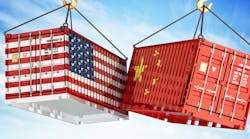Last year, more than 171,000 jobs were “reshored” in the U.S., following a total of 67,000 reshorings between 2010 and 2016, according to the Reshoring Initiative. This brought the total number of manufacturing jobs brought to the U.S. from offshore in excess of 576,000 (since the manufacturing employment low of 2010), the group reports. In total, the number of reshored jobs in 2017 equaled 90% of the 189,000 manufacturing jobs added nationally that year.
“We believe the huge increases were largely based on anticipation of greater U.S. competitiveness due to expected corporate tax and regulatory cuts following the 2016 election,” the Reshoring Initiative states in its annual report. “Similar to the previous few years, foreign direct investment (FDI) continued to exceed reshoring in terms of total jobs added, but reshoring has closed most of the gap since 2015.”
That gap could narrow further this year, thanks in part to the tariff wars and the geographic shifting of manufacturing activities that we’re already seeing as a result of those wars. In fact, the current tariff wars are driving many organizations to rethink the way they align and maximize their global supply chains.
Tariffs Abound
The tariff wars are getting difficult to keep track of, but most recently, the U.S. announced new tariffs on $200 billion worth of Chinese goods. In return, China announced tariffs on $60 billion worth of U.S. goods. According to Business Insider, China's new tariffs affect 5,207 U.S. products and account for as much as 95% of all US exports to China.
Noting that thousands of goods—ranging from dishwashers to Fitbit fitness trackers to food seasonings—were poised to become more expensive, the administration moved ahead with this new round of tariffs. CNN’s Katie Lobosco notes that:
- Dell, Cisco, Juniper Networks, and Hewlett Packard Enterprise, are worried the tariffs will increase the costs of their networking equipment.
- Whirlpool has said that parts it buys from China to make dishwashers in Ohio are on the list.
- Apple said materials used to make chargers and adapters, as well as its Apple Watch and its wireless Air Pods, would be hit.
“If the new taxes do go into effect,” Lobosco writes, “the U.S. will have imposed tariffs on about half of all Chinese goods coming into the United States, or about $250 billion.”
“Factory Asia”
In “Tariffs may well bring some high-tech manufacturing back to America,” The Economist reports that technology firms have been outsourcing production for the last two decades, with Asia being the “dominant hub” for such activity.
Smartphone components, for example, comprise 33% of Taiwan’s exports and 15% of those leaving Singapore and South Korea. And while reshoring some or all of that activity may seem like an obvious choice in the current tariff war environment, actually doing it isn’t as easy as it sounds.
That’s because “Factory Asia” enjoys considerable efficiencies of scale. “Because parts suppliers and final assembly are relatively close together, it is flexible and responsive; a trans-Pacific supply chain would be slower and less efficient,” The Economist points out. “And China’s mammoth smartphone industry hoovers up skilled workers and engineers, creating demand for labor that coaxes a corresponding supply into existence. Filling such jobs in America would be hard, at least in the short run.”
More Than Just Labor
Bringing electronics manufacturing to the U.S. equates to more than just higher worker wages. In “How much would the iPhone cost if it were made in America?,” for example, Emily Stewart writes that most of the added cost of manufacturing at home would come from “attempting to build a system that’s never been in the U.S., but has been built over decades abroad.”
“Apple CEO Tim Cook said last year that he needs a ‘rare’ combination of craftsman-like skill, sophisticated robotics, and computer science,” Stewart writes. “That combination is a system that’s been built over time in countries like China that have made the investment.”
What’s Ahead?
As the tariff situation continues to play out, and as companies look for ways to circumvent the tariffs while maintaining their production and quality levels, expect to see more of them looking at domestic options. Whether this drives up the numbers of reshored manufacturing jobs for 2018 remains to be seen, but the Reshoring Initiative’s Harry Moser is already seeing some positive momentum.
From January to July of 2018, Moser counted 16 cases of companies moving jobs or investments back to the U.S. at least in part because of tariffs or the threat of tariffs. “That is up from 14 for all of last year,” writes Don Lee in “Hdden in strong economic statistics, many US firms at home and in China feeling pain of tariffs,” “and just a handful in previous recent years.”










